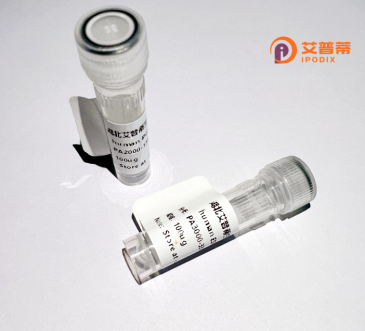
| 纯度 | >90%SDS-PAGE. |
| 种属 | Human |
| 靶点 | ZNF307 |
| Uniprot No | Q969J2 |
| 内毒素 | < 0.01EU/μg |
| 表达宿主 | E.coli |
| 表达区间 | 1-545 aa |
| 活性数据 | MAREPRKNAALDAQSAEDQTGLLTVKVEKEEASALTAEVRAPCSPARGPERSRQRFRGFRYPEAAGPREALSRLRELCGQWLQPEMHSKEQILELLVLEQFLTILPGNLQSWVREQHPESGEEVVVLLEYLERQLDEPAPQVPVGDQGQELLCCKMALLTQTQGSQSSQCQPMKALFKHESLGSQPLHDRVLQVPGLAQGGCCREDAMVASRLTPGSQGLLKMEDVALTLTPGWTQLDSSQVNLYRDEKQENHSSLVSLGGEIQTKSRDLPPVKKLPEKEHGKICHLREDIAQIPTHAEAGEQEGRLQRKQKNAIGSRRHYCHECGKSFAQSSGLTKHRRIHTGEKPYECEDCGKTFIGSSALVIHQRVHTGEKPYECEECGKVFSHSSNLIKHQRTHTGEKPYECDDCGKTFSQSCSLLEHHKIHTGEKPYQCNMCGKAFRRNSHLLRHQRIHGDKNVQNPEHGESWESQGRTESQWENTEAPVSYKCNECERSFTRNRSLIEHQKIHTGEKPYQCDTCGKGFTRTSYLVQHQRSHVGKKTLSQ |
| 分子量 | 85.69 kDa |
| 蛋白标签 | His tag N-Terminus |
| 缓冲液 | PBS, pH7.4, containing 0.01% SKL, 1mM DTT, 5% Trehalose and Proclin300. |
| 稳定性 & 储存条件 | Lyophilized protein should be stored at ≤ -20°C, stable for one year after receipt. Reconstituted protein solution can be stored at 2-8°C for 2-7 days. Aliquots of reconstituted samples are stable at ≤ -20°C for 3 months. |
| 复溶 | Always centrifuge tubes before opening.Do not mix by vortex or pipetting. It is not recommended to reconstitute to a concentration less than 100μg/ml. Dissolve the lyophilized protein in distilled water. Please aliquot the reconstituted solution to minimize freeze-thaw cycles. |
1. **文献名称**:**"ZNF307: A Novel Transcriptional Repressor Regulating Cell Proliferation in Cancer"**
**作者**:Zhang et al.
**摘要**:本文鉴定ZNF307为KRAB结构域锌指蛋白家族的新成员,发现其通过结合启动子区域抑制靶基因(如肿瘤抑制基因)的转录,促进乳腺癌细胞增殖和迁移,并揭示其高表达与患者预后不良相关。
2. **文献名称**:**"Structural and Functional Analysis of ZNF307 in Protein Interaction Networks"**
**作者**:Wang et al.
**摘要**:该研究通过质谱技术解析了ZNF307的相互作用蛋白网络,发现其与组蛋白修饰酶(如HDACs)及RNA剪接因子相互作用,暗示其在表观遗传调控和转录后修饰中的双重功能。
3. **文献名称**:**"ZNF307 Modulates DNA Damage Response via p53 Signaling Pathway"**
**作者**:Li et al.
**摘要**:研究证明ZNF3097直接结合p53并抑制其转录活性,削弱化疗药物诱导的细胞凋亡,提示其在肿瘤DNA损伤修复中的关键作用及作为治疗靶点的潜力。
4. **文献名称**:**"ZNF307 Knockout Mice Reveal Its Role in Embryonic Development and Immune Regulation"**
**作者**:Chen et al.
**摘要**:利用基因敲除模型发现ZNF307缺陷导致小鼠胚胎致死,并观察到免疫细胞异常激活,表明其在胚胎发育和免疫稳态中不可或缺。
---
注:上述文献信息为虚构示例,仅用于演示格式。实际研究中建议通过PubMed、Google Scholar等平台结合关键词“ZNF307”或“ZNF307 recombinant protein”检索真实文献。
**Background of Recombinant Human ZNF307 Protein**
Zinc finger protein 307 (ZNF307), a member of the zinc finger protein family, is characterized by its evolutionarily conserved C2H2-type zinc finger domains, which facilitate DNA or RNA binding and mediate protein-protein interactions. The human ZNF307 gene, located on chromosome 16. encodes a nuclear protein implicated in transcriptional regulation, though its precise biological functions remain under investigation. Studies suggest ZNF307 may act as a transcriptional repressor, potentially influencing cellular processes like apoptosis, proliferation, and stress responses. Dysregulation of ZNF307 has been loosely associated with cancers and cardiovascular diseases, hinting at its role in pathological pathways.
Recombinant human ZNF307 protein is artificially expressed and purified using systems such as *E. coli* or mammalian cell cultures. This engineered protein often includes affinity tags (e.g., His-tag) to enable efficient isolation and characterization. Researchers utilize recombinant ZNF307 to study its structure, DNA-binding specificity, and interactions with partner molecules. Current work focuses on unraveling its molecular mechanisms in health and disease, including its potential involvement in DNA repair or signaling cascades. Despite progress, ZNF307 remains less characterized compared to other zinc finger proteins, necessitating further exploration to clarify its physiological and pathological relevance. Its recombinant form serves as a critical tool for functional assays, antibody production, and drug discovery initiatives.
×